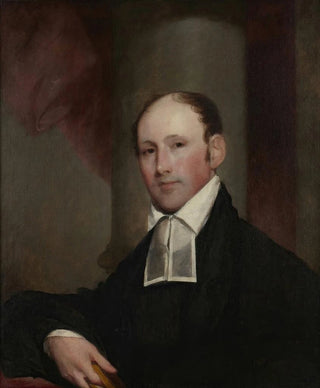Art print | Reverend Charles Burroughs D. D. - Gilbert Stuart


View from behind

Frame (optional)
The artwork "The Reverend Charles Burroughs D. D." by Gilbert Stuart is much more than a simple portrait. It embodies an era when art and culture were closely intertwined with political and social affairs. Created in the early 19th century, this painting depicts a man of faith, an intellectual whose influence extended far beyond the walls of his church. Stuart, master of the portrait, manages to capture not only the physical appearance of his subject but also the very essence of his personality. This painting, with its emotional depth and striking realism, invites the viewer to delve into the spiritual and intellectual universe of the reverend, while revealing the artist's technical mastery.
Style and uniqueness of the work
Gilbert Stuart's style is undeniably distinctive, characterized by a masterful use of light and shadow. In "The Reverend Charles Burroughs D. D.", each brushstroke seems carefully thought out to emphasize the features of the reverend's face, while creating an atmosphere of dignity and respect. The background, simple and nuanced, allows the central figure to stand out strongly, highlighting the refined costume and the serene expression of Burroughs. This portrait does not merely depict a man; it tells a story, that of a man engaged in his era, with deeply rooted values. The color palette chosen by Stuart, both rich and subtle, contributes to the psychological depth of the character, making the painting both timeless and profoundly human.
The artist and his influence
Gilbert Stuart, born in 1755, is often regarded as one of the greatest American portraitists of his time. His work is not limited to simply representing his subjects; it aims to immortalize their character and essence. Stuart had the honor of painting many influential personalities, including George Washington, whose portrait has become iconic. His unique approach to portraiture marked a generation of artists and paved the way for a new way of perceiving portrait painting in America. Through his skill in capturing not only the appearance but

Matte finish

View from behind

Frame (optional)
The artwork "The Reverend Charles Burroughs D. D." by Gilbert Stuart is much more than a simple portrait. It embodies an era when art and culture were closely intertwined with political and social affairs. Created in the early 19th century, this painting depicts a man of faith, an intellectual whose influence extended far beyond the walls of his church. Stuart, master of the portrait, manages to capture not only the physical appearance of his subject but also the very essence of his personality. This painting, with its emotional depth and striking realism, invites the viewer to delve into the spiritual and intellectual universe of the reverend, while revealing the artist's technical mastery.
Style and uniqueness of the work
Gilbert Stuart's style is undeniably distinctive, characterized by a masterful use of light and shadow. In "The Reverend Charles Burroughs D. D.", each brushstroke seems carefully thought out to emphasize the features of the reverend's face, while creating an atmosphere of dignity and respect. The background, simple and nuanced, allows the central figure to stand out strongly, highlighting the refined costume and the serene expression of Burroughs. This portrait does not merely depict a man; it tells a story, that of a man engaged in his era, with deeply rooted values. The color palette chosen by Stuart, both rich and subtle, contributes to the psychological depth of the character, making the painting both timeless and profoundly human.
The artist and his influence
Gilbert Stuart, born in 1755, is often regarded as one of the greatest American portraitists of his time. His work is not limited to simply representing his subjects; it aims to immortalize their character and essence. Stuart had the honor of painting many influential personalities, including George Washington, whose portrait has become iconic. His unique approach to portraiture marked a generation of artists and paved the way for a new way of perceiving portrait painting in America. Through his skill in capturing not only the appearance but






